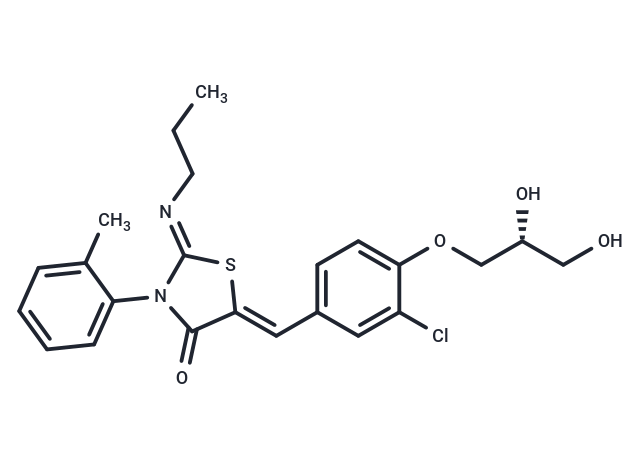Shopping Cart
- Remove All
 Your shopping cart is currently empty
Your shopping cart is currently empty

Ponesimod (ACT-128800) is an orally available sphingosine-1-phosphate receptor 1 (S1PR1, S1P1) agonist with potential immunomodulating activity.

| Pack Size | Price | Availability | Quantity |
|---|---|---|---|
| 1 mg | $38 | In Stock | |
| 2 mg | $54 | In Stock | |
| 5 mg | $85 | In Stock | |
| 10 mg | $133 | In Stock | |
| 25 mg | $246 | In Stock | |
| 50 mg | $425 | In Stock | |
| 100 mg | $628 | In Stock | |
| 500 mg | $1,350 | In Stock | |
| 1 mL x 10 mM (in DMSO) | $98 | In Stock |
| Description | Ponesimod (ACT-128800) is an orally available sphingosine-1-phosphate receptor 1 (S1PR1, S1P1) agonist with potential immunomodulating activity. |
| Targets&IC50 | S1P1 receptor:5.7 nM(EC50) |
| In vitro | Relative to the potency of S1P, the potency of ponesimod at human recombinant receptors was 4.4-fold higher for S1P1 and 150-fold lower for human S1P3. Therefore, ponesimod was ~650-fold more selective for human S1P1 over S1P3 than the natural ligand[1]. |
| In vivo | Ponesimod is a new, potent, and selective S1P1 receptor agonist with pharmacokinetic properties allowing rapid restoration of lymphocyte count in peripheral blood upon discontinuation. Ponesimod prevents edema formation, inflammatory cell accumulation, and cytokine release in the skin of mice with delayed-type hypersensitivity. Ponesimod also prevents the increase in paw volume and joint inflammation in rats with adjuvant-induced arthritis. Selective activation of S1P1 using ponesimod leads to blood lymphocyte count reduction and prevention in models of lymphocyte-mediated tissue inflammation. It has the potential to be as effective in animal models of autoimmunity and human autoimmune disease via its effect on T and B cell blood count. Thus, ponesimod may represent a new therapeutic option for the treatment of autoimmune diseases[1]. Ponesimod is eliminated within 1 week of discontinuation and its pharmacological effects are rapidly reversible [2]. |
| Kinase Assay | The enzymatic reactions are conducted in duplicate at room temperature for 1 hour in a 50 μL mixture containing PKMT assay buffer, substrate coated plate, 10 M SAM, a HMT enzyme (EZH2 (800 ng/reaction), MLL (300 ng/reaction), PRMT1 (0.5 ng/reaction), SUV39H1 (75 ng/reaction) and UNC0638 (0-1.25 μM). After enzymatic reactions, 100 μL of first antibody is added to each well and the plate is incubated at room temperature for an additional 1 h. 100 μL of secondary antibody is added to each well and the plate is incubated at room temperature for an additional 30 min. 100 μL of developer reagents are added to wells and luminescence is measured using a BioTek SynergyTM 2 microplate reader. Enzyme activity assays are performed in duplicates at each concentration. The luminescence data are analyzed using the computer software, Graphpad Prism[1]. |
| Alias | ACT-128800 |
| Molecular Weight | 460.97 |
| Formula | C23H25ClN2O4S |
| Cas No. | 854107-55-4 |
| Smiles | CCC\N=C1/S\C(=C/c2ccc(OC[C@H](O)CO)c(Cl)c2)C(=O)N1c1ccccc1C |
| Relative Density. | 1.30 g/cm3 (Predicted) |
| Storage | Powder: -20°C for 3 years | In solvent: -80°C for 1 year | Shipping with blue ice. | |||||||||||||||||||||||||||||||||||
| Solubility Information | DMSO: 55 mg/mL (119.31 mM), Sonication is recommended. Ethanol: 92 mg/mL (199.58 mM), Sonication is recommended. | |||||||||||||||||||||||||||||||||||
Solution Preparation Table | ||||||||||||||||||||||||||||||||||||
DMSO/Ethanol
| ||||||||||||||||||||||||||||||||||||

Copyright © 2015-2025 TargetMol Chemicals Inc. All Rights Reserved.